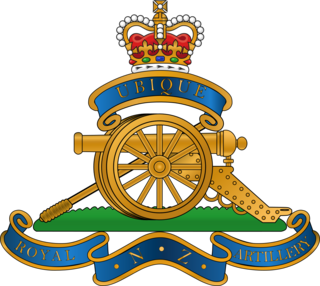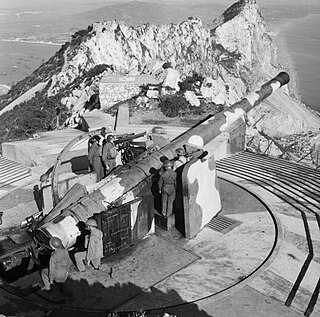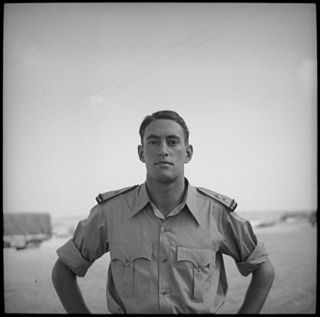History
Since the First World War, the coastal defences of Auckland had come under a single battery, 13 Heavy Battery (13 Coast Battery prior to 1934). In March 1940, 13 Heavy Battery was broken up into three batteries and the overall force increased in manpower. The 9th Heavy Regiment was formed in July 1940 to command the Auckland defence batteries, which included both coastal artillery and anti-aircraft artillery. In 1941, the regiment was expanded to include the coastal artillery batteries which covered other ports in the upper North Island. At its peak size in 1943, the regiment consisted of nine batteries: [2]
The name of the regiment was changed to 9th Coast Regiment in October 1944 and in the same year, the coastal defences were effectively mothballed. After the war it was decided that only the defences at Auckland should be kept in an operational state by a small peacetime garrison. In 1948 the territorial force was reorganised. All the New Zealand Artillery became part of the Royal New Zealand Artillery and the batteries were renumbered as:
- 91 Battery (North Head)
- 93 Battery (Motutapu)
- 94 Battery (Castor Bay)
- 95 Battery (Whangaparoa)
- 96 Battery (Waiheke)
It was decided in 1957 that the coastal artillery regiments were no longer necessary. That decision may have been connected to the British turn towards missiles as expressed by the 1957 Defence White Paper. The armament and equipment were placed on a care and maintenance basis, while the regiment was reduced to a cadre. Over the coming years, the equipment was scrapped and much of the facilities and land were sold off. The regiment eventually dropped to a single quartermaster sergeant, but continued to exist on paper until it was formally disbanded in 1967.

The Royal Regiment of New Zealand Artillery is the artillery regiment of the New Zealand Army. It is effectively a military administrative corps, and can comprise multiple component regiments. This nomenclature stems from its heritage as an offshoot of the British Army's Royal Artillery. In its current form it was founded in 1947 with the amalgamation of the regular and volunteer corps of artillery in New Zealand. In 1958 in recognition of services rendered it was given the title the Royal Regiment of New Zealand Artillery.

Wrights Hill Fortress is a counter bombardment coastal artillery battery in the Karori suburb of Wellington, New Zealand. It was built between 1942 and 1944 and is predominantly underground, with numerous tunnels linking the war shelters, gun emplacements, magazines, plotting rooms and engine room - which are, at some points, over 50 feet underground. The fort was intended to house three 9.2" Mk. XV guns, but only two guns were installed and the fort never saw action. After World War II was over, fort commanders fired both of the guns. The fall of the shot was observed in Cook Strait and these test firings were deemed a success. In 1960, somewhat ironically, both of the guns were sold to the Japanese as scrap metal, the very nation Wrights Hill Fortress was constructed to defend Wellington against. The design of the fort is similar to the Stony Batter and Whangaparāoa 9.2" Mk. XV batteries, near Auckland.

Stony Batter is a historic defence installation at the north-eastern end of Waiheke Island, Auckland, New Zealand. It is sited within a 50-acre scenic reserve of the same name, owned by the New Zealand Department of Conservation (DOC). The park serves double duty as a historical and nature reserve, containing unusual rock formations, associated with an extinct volcano, three significant bush blocks and three concrete gun emplacements with an extensive tunnel system, reputed to be the largest in New Zealand.

The Sri Lanka Artillery (SLA) is the artillery arm of the Sri Lanka Army. It is made up of ten regular regiments and two volunteer regiments. The SLA is headquartered at Panagoda Cantonment, Panagoda.

The BL 6-inch gun Mark VII was a British naval gun dating from 1899, which was mounted on a heavy travelling carriage in 1915 for British Army service to become one of the main heavy field guns in the First World War, and also served as one of the main coast defence guns throughout the British Empire until the 1950s.

Coastal fortifications were constructed in New Zealand in two main waves: around 1885 as a response to fears of an attack by Russia, and in World War II due to fears of invasion by the Japanese.

The QF 12 pounder 18 cwt gun (Quick-Firing) was a 3-inch high-velocity naval gun used to equip larger British warships such as battleships for defence against torpedo boats. 18 cwt referred to the weight of gun and breech, to differentiate the gun from others that also fired the "12 pound" shell.

The BL 9.2-inch Mk IX and Mk X guns were British breech loading 9.2-inch (234 mm) guns of 46.7 calibre, in service from 1899 to the 1950s as naval and coast defence guns. They had possibly the longest, most varied and successful service history of any British heavy ordnance.

The BL 8 inch guns Mark I to Mark VII were the first generations of British rifled breechloaders of medium-heavy calibre. They were initially designed for gunpowder propellants and were of both 25.5 and 30 calibres lengths.

The 3rd Field Regiment, Royal New Zealand Artillery was a territorial force Field Artillery regiment of the New Zealand Army. The unit was formed in 1921 and consisted of the field artillery batteries based in the South Island. The regiment remained in New Zealand during the Second World War and was tasked with training reinforcements for 2nd New Zealand Expeditionary Force. The regiment was disbanded in 1990.

The 11th Coast Regiment, Royal New Zealand Artillery was a territorial coastal artillery regiment of the New Zealand Army based at Godley Head. The regiment was formed in 1940 as 11th Heavy Regiment, New Zealand Artillery and controlled the coastal defence batteries around Lyttleton Harbour. The regiment was progressively expanded and by the end of the war had batteries all over the upper North Island. The regiment was reduced to a cadre in 1957 and disbanded in 1967, along with the other coastal artillery regiments.

The 13th Coast Regiment, New Zealand Artillery was a coastal artillery regiment of the New Zealand Military Forces. It was formed in May 1943 from the coastal defence batteries based in the lower South Island, which were formerly part of 11th Coast Regiment. The regiment consisted of:

Culver Battery is a former coastal artillery battery on Culver Down, on the eastern side of the Isle of Wight, England. The fortification is one of several Palmerston Forts built on the island following concerns about the size and strength of the French Navy in the late 19th century. It was operational during the First and Second World Wars. The battery was closed in 1956.

Fort Ballance is a former coastal artillery battery on Point Gordon on Wellington's Miramar Peninsula.
Barrett Point is located at the foot of Mount Hayes at the entrance to Prince Rupert Harbour at 54°14′28″N130°20′02″W. It was a coastal fortification during World War II.

Lieutenant General Sir Leonard Whitmore Thornton, was a senior officer in the New Zealand Army.
The Tynemouth Volunteer Artillery claims to be the oldest volunteer artillery unit of the British Army. It served coastal and siege guns in World War I and World War II, and also served in the infantry role.

The 2nd Devonshire Artillery Volunteers was a unit of the British Volunteer Force and Territorial Army. The unit and its successors defended Plymouth Dockyard and the Devon coast from 1861 to 1961.

The 10th Coast Regiment, Royal New Zealand Artillery was a territorial coastal artillery regiment of the New Zealand Army. The regiment was formed in 1940 as 10th Heavy Regiment, New Zealand Artillery and controlled the coastal defence batteries around Wellington Harbour. The regiment was progressively expanded and by the end of the war had batteries all over the lower North Island. The regiment was reduced to a cadre in 1957 and disbanded in 1967, along with the other coastal artillery regiments.

The 6th Light Anti-Aircraft Regiment, Royal New Zealand Artillery was a territorial air defence regiment of the New Zealand Army. It was formed in 1948 and equipped with 40mm Bofors anti-aircraft guns. The regiment was disbanded in 1961.















